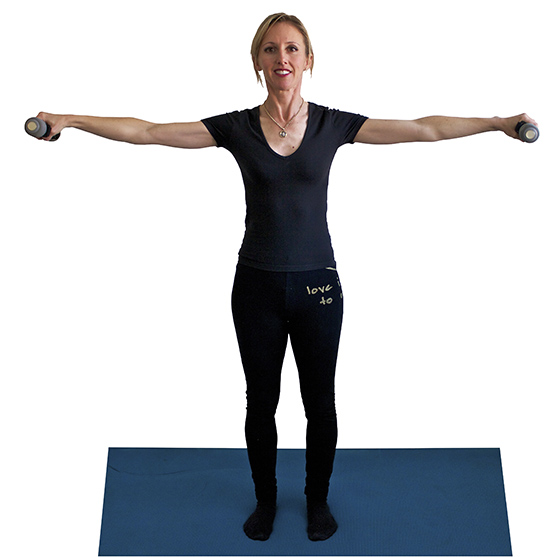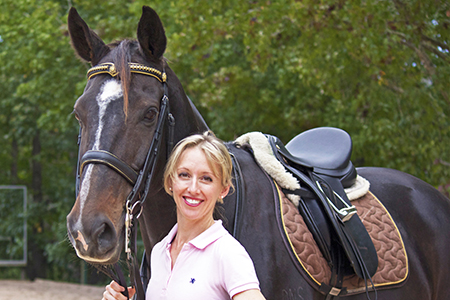The control of our upper body should be focused in what we term the shoulder girdle. This is the area that wraps around us like a corset just under the shoulder joints.
The shoulder joints belong to the horse. They must remain moveable and elastic, as this is where the soft hand is initiated, not just in the wrist or elbow. These joints are also very shallow and therefore not very strong. You will be much more effective with the stability of your body and your influence on the horse if the control comes from the shoulder girdle instead of the arm.
A wide chest and back and relaxed shoulders will encourage the shoulder blades to be anchored and flush against the rib cage. We are looking for evenness in the body, so think that the sternum is bolted into the chest without hunching through the mid-back.
In these two exercises, we want to find the muscle under our shoulder blades called the latissimus dorsi. It is a big, triangular muscle that runs from the back of the upper arm right across the side of the back into the lower vertebrae and sacrum. This is the muscle that is going to help stabilise the shoulder blades. You can feel it if you wrap one arm around the front of the body and place it below the armpit on the other side then reach down to the ground with the arm that is hanging by your side.
Stabilisation One:
The Set Up:
– Find neutral spine*, lying on your tummy and resting on your elbows and forearms so that the upper arm is perpendicular to the floor, hands together with fingers interlaced to form a triangle with your forearms.
– Switch off your outer muscles, relaxing your legs.
– On an in breath, using the lateral breathing* method, switch on your core* by imagining the low abdominals melting inwards towards your spine and lifting up gently through the pelvic floor. When breathing, imagine filling up your lungs completely, including the sides and back, not just the front. The shoulders remain relaxed and still.
Instruction Of Move:
– Breathe out and pull yourself up over your forearms and hands, lifting up out of your shoulders by sliding the shoulder blades down your back in a soft V. Elongate the body and float the head up to the ceiling.
– Relax back to start position.
Small Addition:
As you pull yourself over your arms, gently stretch your neck by tipping your ear to your shoulder, one side then the other to release any tension in the neck. Releasing the neck and the area across the top of the shoulders allows the shoulder girdle to be freely suspended and the lats to engage.
Visualisations:
– Lift up off a drawing pin or little bird under your belly button to keep core engaged
– Keep lower back gently lengthened
– Chest and back are wide
– Keep a connection down the front of your body
– Lift your back up between the shoulder blades without causing it to hump
Watch Out For:
– Flaring ribs
– Over arching back
– Pinching shoulder blades together
– Tensing your legs
Stabilisation TWO: Arm Floats
The Set Up:
– Find neutral spine*, standing with feet parallel and hip joint width apart along with the knees.
– Switch off your outer muscles, relaxing your arms and neck. Arms hang loosely by your side.
– On an in breath, using the lateral breathing* method, switch on your core* by imagining the low abdominals melting inwards towards your spine and lifting up gently through the pelvic floor.
Instruction Of Move:
– On an in breath, allow the arms to float up to shoulder height keeping the shoulders from creeping higher.
– Breathe out and lower arms back to start position.
Visualisations:
– Allow the shoulder blades to slide down the back rather than forcing them down strongly. This strong action could cause excessive strain in the body and nerve impingement.
– Chest and back both wide
– Neck is long
– Back of head is being gently lifted to the ceiling by a string
– Resist with the arms as they move up and down
– Stretch arms away from you
Watch Out For:
– Hunching shoulders
– Raising arms to different levels or too high
– Movement through the torso
– Leaning forward or back with the body
Variation:
You can hold small weights. They donít need to be heavy, just enough to help you connect your upper arm into the lats.
Glossary
*Neutral Spine: This is the shape of the spine when all the vertebrae are stacked one upon the other in alignment. The spine is concave in the lower back and the neck. These natural curves allow for good shock absorption. This is what we term a neutral spine position and we want to maintain this alignment when we ride.
*Core: Your core is made up of some very deep muscles that help support your structure. They form a type of box in your lower abdomen. The top of the box is the diaphragm, the sides are formed by the internal obliques, and at the back is the multifidus which supports the vertebrae. At the front is the transversus abdominis and on the bottom is the pelvic floor. Thatís a lot of muscles to think about, so we focus mainly on the transversus and pelvic floor. Good breathing techniques will help take care of the diaphragm and correct exercise technique will support healthy obliques and multifidus. There are many ways to switch on the core, but the best way is to use imagery. Think that you are gently tightening a hipster belt, drawing up a pelvic elevator, stopping the flow of urine or melting your lower abs into your spine.
*Lateral breathing: This is style of breathing where we breathe in through the nose and out through the mouth. It helps support the core. Think of filling up the lungs without losing the engagement of the core or lifting the shoulders up. Remember to breathe into the sides and back of the lungs, not just the front. Donít forget, if youíre not used to good breathing techniques, the diaphragm and the intercostal muscles that control the rib cage will need time to learn to work properly, just like any other muscle.
This article first appeared in the October 2012 issue of THM.

